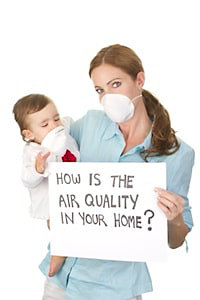7 Important Indoor Air Quality Facts & Statistics

March 30, 2012
Indoor air pollution is something every home in America struggles with. Since 1970 homes have been built “tighter” to conserve energy.
But that same tight construction reduces ventilation, traps indoor air pollutants inside your home and could be making you sick. Here are seven facts and statistics regarding your health and your home’s indoor air quality, according to the Environmental Protection Agency (EPA).
You spend about 90% of your time indoors.
At work, at school and at home, if you are like most people, you spend almost all of your time inside. This should be a major concern, when you consider this and the next fact together.
The quality of indoor air can be two to five times (and even up to 100 times) more polluted than the worst outside air.
Most people recognize the health concerns that outdoor air pollution poses, but few consider that exposure to poor indoor air quality has the same ill health effects.
The EPA has ranked indoor air pollution among the top five environmental dangers.
The Environmental Protection Agency has recognized that poor indoor air pollution is a very real problem and ranked it among the top of the environmental dangers facing the public.
There has been an alarming increase in the number of children with severe allergies and asthma.
The amount of children and young adults with severe allergies and asthma continues to climb every year. This has been linked to increasingly poor indoor air quality.
Allergies, asthma, lung cancer and heart problemshave all been linked to poor air quality.
The American Heart Association has linked poor air quality to heart problems while the American Lung Association lists it as a leading cause of lung cancer.
Sources of indoor air pollution are all around you.
Studies conducted by the EPA have shown that indoor air pollution is a problem for all types of homes, whether in a dense urban city or a rural town. Some of the sources include:
- Combustion sources: gas, oil, kerosene and wood stoves or fireplaces, tobacco smoke
- Building materials: insulation, carpet, cabinetry, pressed wood products
- Chemical products: cleaning products, personal care products, glues, pastes
- Outdoor sources: radon, pesticides, pollen, outdoor air pollution
- Other: pet dander, dust mites, mold, virus
DUE TO AN ABNORMALLY WARM WINTER THIS YEAR
the pollen counts are 800% higher (or 8 times greater) than normal and will find their way INTO YOUR HOME.
You inhale approximately 15,000 or more quarts of air per day.
You likely understand the health benefits of clean water, of which you consume about two quarts per day. Yet, most people are unaware of or ignore the importance of breathing clean air, as well.
Don’t ignore your home’s very real indoor air quality problem. Cool Today offers a variety of products designed to improve your home’s air quality and help you breathe easier.
Contact us online today or call 800-226-2636 for more information.
Posted in: Tips